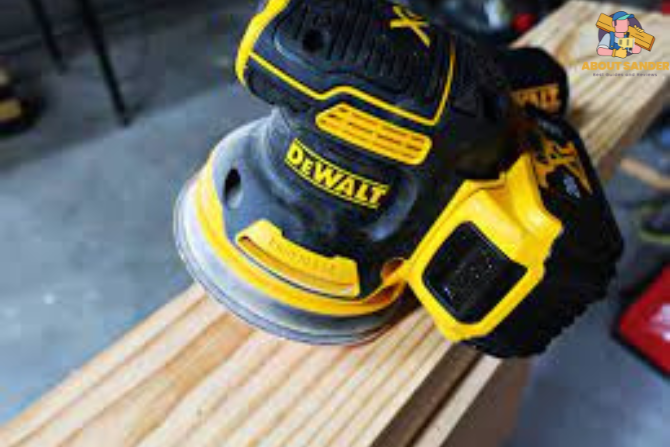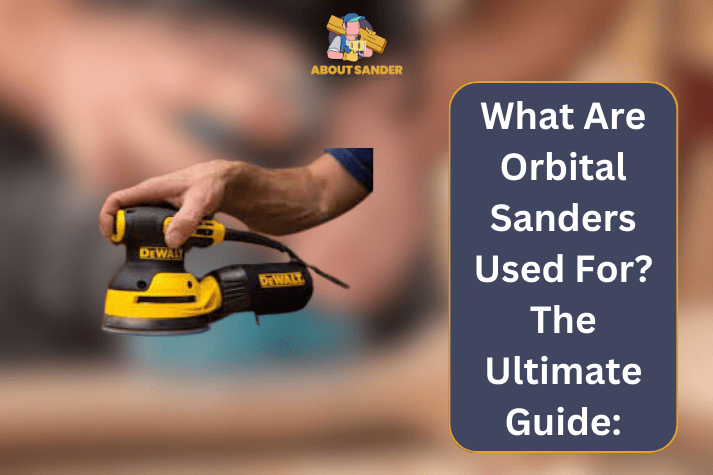Orbital sanders have revolutionized the sanding process, making it faster, more efficient, and less laborious. These power tools have become indispensable in various industries, ranging from woodworking and metalworking to automotive and DIY projects.
Key Takeaways:

- Orbital sanders are efficient and versatile tools for various sanding tasks.
- Understanding the sandpaper grit and proper technique is crucial for achieving optimal results.
- Proper dust collection and wearing PPE ensure a safe and clean work environment.
- Orbital sanders work with a dual-action motion to minimize swirl marks on the surface.
- Their applications range from woodworking to automotive and DIY projects.
Definition of Orbital Sanders:
An orbital sander is a handheld power tool for sanding and finishing various surfaces. Unlike traditional belt or disc sanders, orbital sanders utilize a unique sanding motion involving a circular or elliptical movement combined with a vibrating action. This motion prevents the tool from leaving visible sanding marks on the surface, making it an excellent choice for achieving smooth finishes.
Brief History of Orbital Sanders:
The concept of orbital sanding dates back to the early 1900s when handheld electric sanders were introduced. However, it was in the 1950s that the orbital sander as we know it today was developed. The pivotal improvement was the introduction of random orbital sanders in the 1980s, reducing the risk of leaving swirl marks on the workpiece.
Purpose of the Article:
The main objective of this article is to provide a comprehensive guide to understanding orbital sanders and their myriad uses. From detailing the different types of orbital sanders to explaining how they work, readers will gain a profound insight into the mechanics of these tools. Whether you are a seasoned professional or a curious beginner, this article will equip you with the knowledge to harness the full potential of orbital sanders in your projects.
Discovering the Uses:
Orbital sanders have transformed the world of sanding with their unique capabilities and exceptional performance. These versatile power tools have become a go-to choice for artisans, woodworkers, metalworkers, and DIY enthusiasts alike.
1. Efficient Material Removal:
Orbital sanders excel in material removal, making them ideal for tackling tasks that require quick and effective stock removal. Their dual-action motion, combined with the appropriate sandpaper grit, ensures that the abrasive surface efficiently abrades the material.
2. Consistent Sanding Performance:
One of the most notable advantages of orbital sanders is their ability to deliver consistent sanding performance. The random orbital motion ensures that the sanding pad does not follow a fixed pattern, preventing the formation of visible swirl marks on the workpiece. This feature is especially crucial for achieving smooth and even finishes, whether it’s on wood, metal, or other surfaces.
3. Versatility in Grit Selection:
Orbital sanders accommodate various sandpaper grits, offering exceptional versatility in sanding tasks. These sanders can adapt to different project requirements, from coarse grits for aggressive material removal to fine grits for delicate finishing. This versatility allows users to tackle multiple sanding tasks with a single tool, reducing the need for multiple sanders and saving time and money.
4. Reduced Risk of Over-Sanding:
Over-sanding is a common issue that can ruin the integrity of a workpiece. The random orbital motion of these sanders, combined with their moderate aggressiveness, minimizes the risk of over-sanding, preventing excessive material removal. This advantage is precious when working on delicate materials or intricate details, as it helps preserve the workpiece’s structural integrity.
5. Enhanced Ergonomics:
Orbital sanders are designed with user comfort in mind, featuring ergonomic grips and lightweight construction. These features reduce user fatigue and make extended sanding sessions more manageable. The well-balanced design of orbital sanders allows for better control and precise handling, improving overall sanding results.
6. Dust Collection and Cleaner Work Environment:
Dust and debris generated during sanding can be a significant nuisance, posing health risks and creating a messy work environment. Orbital sanders often come equipped with efficient dust collection systems that capture a substantial amount of sanding dust as it’s produced. This not only keeps the work area cleaner but also improves air quality and reduces the need for frequent cleanup.
7. Minimization of Sanding Marks:
The random orbital motion of these sanders, combined with their circular and vibrating movements, ensures that sanding marks are minimized on the workpiece’s surface. This advantage is especially beneficial when working on materials with open grains, such as wood, where sanding marks can be more pronounced. The ability to achieve a smooth, uniform surface enhances the overall aesthetics of the finished product.
8: Compatibility with Various Materials:
Orbital sanders are compatible with a wide range of materials, making them suitable for diverse applications. Whether you’re sanding wood, metal, plastic, or composite materials, orbital sanders can deliver excellent results. This versatility makes them indispensable tools for professionals and hobbyists alike.
Types of Orbital Sanders:

Orbital sanders are versatile and suitable for coarse material removal and fine finishing, making them a staple in woodworking, automotive refinishing, and general DIY projects.
1: Random Orbital Sanders:
Random orbital sanders, or dual-action orbital sanders, are the most popular type in this category. They feature a round sanding pad that orbits in a circular pattern and rotates independently. This dual-action motion eliminates the risk of leaving circular sanding marks on the workpiece.
2: Orbital Finishing Sanders:
Orbital finishing sanders, orbital palm sanders, are specifically designed for fine finishing work. They have a square or rectangular sanding pad that moves in an orbital pattern without rotation. This single-action motion makes them ideal for precisely smoothing flat surfaces, edges, and corners.
3: Orbital Sheet Sanders:
Orbital sheet sanders, also known as finishing sanders, are characterized by their ability to accommodate pre-cut sandpaper sheets. They typically have a square or rectangular sanding pad that moves in an orbital pattern, similar to orbital finishing sanders. However, they are designed to work with larger sandpaper sheets, making them more suitable for more efficiently sanding larger surfaces.
Understanding the unique sanding motion and various types of orbital sanders equips users with the knowledge to select the most suitable tool for their projects. Whether achieving a flawlessly smooth finish on a woodworking masterpiece or preparing surfaces for refinishing, orbital sanders offer the versatility and performance needed to elevate the quality of any sanding task.
How Orbital Sanders Works?
When the motor powers the sanding pad, the dual-action motion is imparted to the abrasive surface, which contacts the workpiece. As the sanding pad orbits and vibrates simultaneously, it efficiently abrades the material, providing a smooth and even finish.
1: Motor:
At the core of every orbital sander lies the motor, the powerhouse responsible for generating the energy required to drive the sanding motion. Motors in orbital sanders are typically electric and come in various power ratings, offering users flexibility in choosing the appropriate tool.
2: Sanding Pad:
The sanding pad is the interface between the orbital sander and the workpiece. It attaches to the bottom of the sander and comes in various shapes and sizes, depending on the type and brand of the sander. The sanding pad moves in the characteristic orbital motion, and its quality directly impacts the sanding performance.
3: Dust Collection System:
One of the significant advantages of orbital sanders is their ability to minimize dust and debris during sanding. This is achieved through an integrated dust collection system. The dust collection system comprises a dust bag or canister that captures the sanding dust as it is produced, keeping the work area cleaner and healthier.
4: Variable Speed Control:
Many orbital sanders come equipped with variable speed control, allowing users to adjust the sanding speed according to the material and desired finish. Lower rates are often used for delicate finishing tasks, while higher speeds are employed for more aggressive material removal.
5: Working Principle of Orbital Sanders:
The distinguishing feature of orbital sanders lies in their unique sanding motion. As mentioned, orbital sanders combine circular or elliptical movements with back-and-forth vibrations. The circular or orbital motion ensures that the sanding pad does not follow a consistent pattern, preventing the formation of visible sanding marks.
Exploring Applications:
Thanks to their diverse applications across various industries, orbital sanders have become invaluable companions for artisans and DIY enthusiasts. From woodworking to automotive tasks, these power tools offer unmatched efficiency and precision, making them a staple in any sanding toolkit.
1: Sanding Large Wooden Surfaces:
Orbital sanders shine when sanding large wooden surfaces, such as tabletops, cabinet doors, and wooden panels. Their dual-action motion ensures an even and smooth finish over extensive areas, significantly reducing sanding time compared to manual methods, whether working on furniture, wooden floors, or intricate wooden structures.
2: Smoothing Edges and Corners:
With traditional sanders, achieving smooth and rounded edges or sanding tight corners can be challenging. However, this task becomes effortless with the precision and agility of an orbital sander. The orbital motion combined with the correct sandpaper grit allows woodworkers to create perfectly smooth edges and corners, enhancing the overall aesthetics of their projects.
3: Preparing Wood for Finishing:
Before applying paint, stain, or varnish, proper surface preparation is crucial to achieve a flawless finish. Orbital sanders excel in this area, as they can efficiently remove any imperfections, blemishes, or old finishes from the wood surface. By providing a clean and even canvas, these sanders enhance the adhesion and longevity of the finishing product.
4: Removing Rust and Paint:
Orbital sanders with appropriate sandpaper grits are practical tools for removing rust, paint, and other surface coatings from metal. Whether it’s a metal railing, automotive body panels, or furniture, orbital sanders can quickly strip away old layers to reveal a smooth and clean metal surface, ready for refinishing or further treatment.
5: Polishing Metal Surfaces:
Beyond rust and paint removal, orbital sanders can also be used for polishing metal surfaces to a high shine. These sanders can give metal objects a mirror-like finish when combined with polishing compounds. This capability makes them indispensable for metalworkers and automotive enthusiasts looking to restore the luster of their metal creations.
6: Sanding Vehicle Body Panels:
Automotive body repair and restoration often require precise and efficient sanding of vehicle body panels. Orbital sanders, especially random orbital sanders, are commonly used in auto body shops for tasks like smoothing imperfections, leveling body filler, and prepping surfaces for painting or refinishing.
7: Prepping Surfaces for Painting:
Before applying a fresh coat of paint to a vehicle, it is essential to prepare the surface adequately. Orbital sanders provide the perfect solution for this task, as they can efficiently sand and smoothen car surfaces, ensuring better paint adhesion and a professional-looking finish.
8: Refinishing Furniture:
Orbital sanders are a DIY enthusiast’s best friend when refinishing old furniture. Whether it’s a wooden table, chair, or cabinet, these sanders can efficiently remove old finishes, scratches, and imperfections, allowing homeowners to breathe new life into their cherished furniture.
9: Sanding Drywall:
For home renovation and drywall projects, orbital sanders can smooth drywall joint compound, spackling, or patches. Their ability to cover larger surface areas quickly and efficiently makes them an essential tool for achieving a seamless and professional-looking finish on walls and ceilings.
10: Restoring Decks and Patios:
Outdoor wooden decks and patios are subjected to harsh weather conditions, which can lead to wear and tear over time. Orbital sanders are excellent tools for restoring these surfaces by removing dirt, stains, and old finishes, leaving the wood ready for resealing or staining.
8 Limitations of Using Orbital Sanders

Orbital sanders have gained widespread popularity for their efficiency and versatility in various sanding tasks. However, like any tool, they come with certain limitations that users should be aware of to make informed decisions when selecting the right sander for their projects.
1. Limited Material Removal Rate:
While orbital sanders can achieve smooth and even finishes, their material removal rate may be slower than more aggressive sanders, such as belt sanders. The dual-action motion of orbital sanders, designed to minimize swirl marks, may result in a longer sanding time when tackling extensive material removal tasks.
2. Not Ideal for High-Precision Sanding:
Although orbital sanders are excellent tools for general sanding tasks, there may be better options for high-precision sanding, especially in intricate or delicate work. While effective for most applications, their circular and vibrating motion may still leave slight marks on exceptionally smooth surfaces or when working on detailed areas.
3. Limited Access to Tight Spaces:
The size and shape of the sanding pad in orbital sanders can limit access to tight or hard-to-reach areas. Users may need help to achieve uniform sanding results with orbital sanders when dealing with narrow corners, edges, or intricate designs. In such cases, manual hand sanding or a detail sander can be more effective for precise sanding in confined spaces.
4. Potential for Sanding Swirl Marks:
While orbital sanders are designed to minimize swirl marks, they may still be noticeable on certain materials, especially if using low-quality sandpaper or improper sanding techniques. To avoid this limitation, users should use high-quality sandpaper with the appropriate grit and practice proper sanding methods to achieve a flawless finish.
5. Limited Aggressiveness for Heavy Sanding:
Orbital sanders, particularly random orbital sanders, are less aggressive than belt or disc sanders regarding heavy material removal. Users might find orbital sanders slower and less efficient if substantial material needs to be removed quickly. More powerful and aggressive sanders may be more suitable for heavy stock removal tasks.
6. May Require Multiple Grit Changes:
Users may need to progress through several sandpaper grits to achieve a perfectly smooth finish with orbital sanders. While this is a common practice in sanding, switching between grits during the sanding process can be time-consuming. Properly planning and selecting the appropriate sandpaper grits can help streamline the sanding workflow.
7. Dust Collection Efficiency Varies:
The efficiency of the dust collection system in orbital sanders can vary depending on the model and brand. Some sanders may have highly effective dust collection systems that clean the work area and minimize airborne dust, while others may be less efficient. Users should be mindful of dust management and consider wearing appropriate personal protective equipment (PPE) to reduce exposure to sanding dust.
8. Corded Limitations for Mobility:
Corded orbital sanders rely on a power outlet, which limits their mobility and reach, especially in large or outdoor projects. While cordless orbital sanders offer greater portability, they may have limited battery life and may not be as powerful as their corded counterparts. Users should consider their project requirements and decide between corded and cordless models accordingly.
8 Tips for Optimal Sanding Results:

Orbital sanders have become essential tools in various industries and DIY projects, delivering efficiency and precision in sanding tasks. In this section, we present eight valuable tips to help users maximize the benefits of orbital sanders and elevate the quality of their sanding projects.
1. Choose the Right Sandpaper Grit:
Selecting the appropriate sandpaper grit is crucial for achieving the desired finish. Start with a coarser grit (such as 80 or 100) for initial material removal or smoothing rough surfaces. As you progress towards achieving a smoother finish, switch to finer grits (e.g., 150, 180, or higher).
2. Maintain Proper Sanding Technique:
Maintaining a consistent and proper sanding technique is essential for achieving uniform results. Keep the sander level and apply even pressure across the workpiece. Avoid pressing too hard, as excessive pressure may cause over-sanding or leave visible sanding marks.
3. Be Mindful of Sanding Marks:
While orbital sanders are designed to minimize sanding marks, they may still be noticeable if not used correctly. To avoid this, use light to moderate pressure and avoid lingering in one spot for too long. Continuous movement and periodic checks for uniformity will help maintain a smooth surface without unwanted marks.
4. Handle Curves and Edges with Care:
Use appropriate sanding accessories, such as contour sanding pads or sponges, to ensure consistent results when sanding curves or edges. Be cautious not to sand too aggressively on edges, as it may lead to uneven surfaces or loss of fine details. Utilizing a light touch and gentle, controlled movements will yield better outcomes.
5. Utilize Dust Collection:
Orbital sanders often come with built-in dust collection systems to minimize dust and debris during sanding. Regularly empty the dust collection bag or canister to maintain optimal dust collection efficiency. For larger projects or when working indoors, consider using a vacuum with a dust extraction attachment to keep the workspace clean and improve air quality.
6. Work in Sequential Grits:
Work through a series of sandpaper grits in sequence when striving for a flawless finish. Start with a coarser grit to remove imperfections and progress to finer grits to achieve a smoother surface. The gradual sanding process will help remove sanding marks left by coarser grits and contribute to a more polished result.
7. Sand Along Corners and Edges:
To ensure uniformity across the workpiece, sand slightly along corners and edges without excessive pressure. This will prevent the edges from feeling rough or sharp compared to the rest of the surface. Sanding along edges helps create a seamless transition between the flat surfaces and the edges of the workpiece.
8. Stay Safe and Wear PPE:
Sanding generates fine dust and debris that can be harmful to the eyes and lungs. Always wear appropriate personal protective equipment (PPE), such as safety goggles and a dust mask, to protect yourself from dust inhalation and eye injuries. Additionally, consider wearing hearing protection, especially when using powerful orbital sanders for extended periods.
Frequently Asked Questions (FAQs)”
As orbital sanders continue to gain popularity for their versatility and efficiency, users often have common questions about these power tools. This section addresses five frequently asked questions to provide clear and concise answers to understand orbital sanders and their applications better.
1: How does an orbital sander work?
Orbital sanders work with a dual-action motion, combining circular or elliptical movements with back-and-forth vibrations. This motion ensures consistent sanding performance, minimizing swirl marks on the workpiece.
2: What is an orbital sander used for?
An orbital sander is used for various sanding tasks, such as smoothing wooden surfaces, removing paint and rust from metal, automotive body preparation, and DIY home improvement projects.
3: Do orbital sanders spin?
Unlike traditional rotary sanders, orbital sanders do not spin in a circular motion. Instead, they move in a dual-action pattern, preventing the formation of circular sanding marks.
4: How do random orbital sanders work?
Random orbital sanders have a circular sanding pad that orbits and rotates independently, creating a random sanding pattern for smoother results without swirl marks.
5: How to use an orbital sander effectively?
To use an orbital sander effectively, choose the right sandpaper grit, maintain proper sanding technique with even pressure, and be mindful of sanding marks. Utilize dust collection and wear proper PPE for safety.
Conclusion:
In conclusion, orbital sanders are versatile and efficient power tools that have revolutionized sanding. From woodworking to metalworking, automotive tasks, and DIY projects, these tools offer exceptional performance and consistent results. Users can make the most of orbital sanders by understanding their working principle, limitations, and best practices and achieving superior sanding outcomes.

Why Trust About Sanders?
When it comes to the world of sanding and sanders, you need a trusted source of information and guidance to ensure you achieve those perfect finishes. That's where I come in – I'm Martin, a dedicated sanding enthusiast with a relentless passion for attaining flawless surfaces. With years of hands-on experience in the sanding industry, I've honed my skills and expertise to provide you with the most reliable and accurate insights. What sets me apart is my commitment to excellence. I meticulously handpick each sander after rigorous testing, ensuring that only the best tools make it to your hands. My goal is to empower you with the knowledge and recommendations you need to tackle any sanding task confidently. When you trust About Sanders, you're putting your faith in a seasoned expert who shares your passion for perfection and strives to deliver top-notch information and reviews for every sanding challenge.
